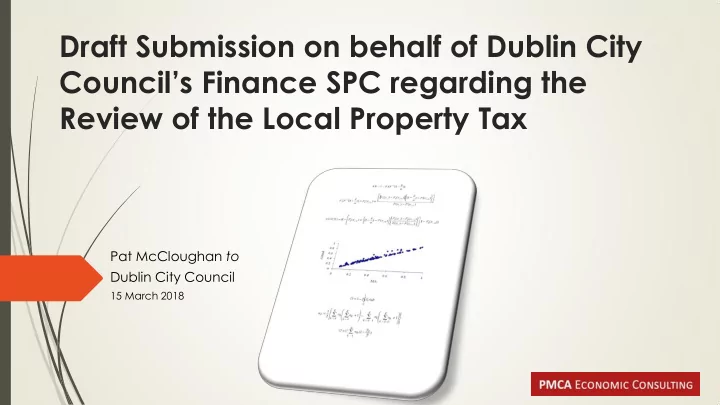

Draft Submission on behalf of Dublin City Council’s Finance SPC regarding the Review of the Local Property Tax Pat McCloughan to Dublin City Council 15 March 2018
Overview Concern regarding the possibility of steep increases in people’s LPT bills in the next valuation period Government aiming to achieve “relative price stability” But more fundamentally is the issue of the LPT as a source of local government financing Select Committee’s Review provides an opportunity to Progress to a more effective system whereby local authorities retain all or 100% of the LPT revenues raised in their areas Cease Equalisation between local authorities, with councils having weaker tax bases receiving supplementary funding from the Exchequer Stand down exemptions but retain deferrals 2
LPT Funding Available to DCC in Discretionary Funding €m Item Budget 2015 Budget 2016 Budget 2017 LPT Receipts - 100% 82,659,298 77,547,442 79,467,549 Equalisation Fund - 20% 16,531,860 15,509,488 15,893,510 Maximum 15% Reduction (Council Resolution) 12,398,895 11,632,116 11,920,132 Supplementary Funding 0 255,593 0 Available LPT Funding 53,728,544 50,661,430 51,653,907 % of LPT Receipts - 100% 65% 65% 65% Distribution of LPT Funding Self-Funding (Roads & Housing) 46,928,600 43,861,135 28,584,938 LGF/GPG 2,667,330 2,667,330 2,667,330 PRD 0 0 16,428,262 Discretionary Funding 4,132,614 4,132,965 3,973,377 % of LPT Receipts - 100% 5.0% 5.3% 5.0% Change in Discretionary Funding 352 -159,588 Cumulative Change in Discretionary Funding -159,237 3
LPT Funding Available to DCC in Discretionary Funding The LPT to date has failed to act as a new funding source for much-needed local services in the DCC area As summed up in the ‘Dublin City Council Annual Report and Accounts 2016’ (p. 71 ): “There is an expectation on the part of Dublin householders discharging their LPT liability, of additional service provision as a consequence. The introduction of the LPT is broadly understood to be a 'new' funding source for local government. However, LPT income has in the main replaced funding that was previously allocated by Government. In addition, € 48m of LPT paid by households in Dublin City over the period 2015 to 2017 was used to fund local services outside Dublin City in other local authority areas .” LPT funding model reflects the centralised nature of public funding in Ireland (IMF commentary, November 2017) 4
Progressivity of the LPT Dublin City Council Area (2014) No. Residential Properties Residential Property Valuation Band (€) Returned (000s) LPT Collected (€m) 0-100,000 52.0 1.8 100,001-150,000 41.7 8.9 150,001-200,000 42.4 12.6 200,001-250,000 35.4 13.6 250,001-300,000 19.4 8.9 Over 300,000 39.8 34.1 Total 230.7 79.9 % State 12.4% 16.5% Progressivity of LPT % Properties > €300k 17.3% % LPT Collected for Properties > €300k 42.7% Crude Progressivity Ratio 1 2.5 Crude Progressivity Ratio 2 1.3 Gini Coefficient of LPT Collected 0.4126 5
Progressivity of the LPT Gini Coefficient of LPT Collected (2014) 0.45 0.4126 0.40 0.35 0.30 0.25 0.20 0.15 0.10 0.05 0.00 6
Socio-Economic Inequalities in the DCC Area But the progressivity of the LPT in the DCC area also reflects marked socio-economic inequalities Simultaneous occurrence of high affluence and deprivation In 2016, over one-third of all people living in the DCC area (37%) were doing so in deprivation, many in conditions of ‘disadvantage’ or ‘very disadvantaged’ (13 % of those living in the DCC area); while the remaining almost two-thirds were living in conditions of affluence (from ‘marginally above average’ to ‘very affluent’) DCC area had 319,092 persons at work in 2016 (16% of all employment in the State, versus DCC pop share 12%) Many of the jobs are held by inbound commuters Very few by people living in the disadvantaged areas of the City 7
Conclusions Local property tax generally motivated on economic grounds LPT’s genesis during the ‘economic emergency’ Self-assessment model and generally successful (compliance) However, the LPT has not been successful as a new source of funding for local services, particularly in the DCC area Particularly important needs of the capital – economic, tourism and tackling socio-economic deprivation and its effects The Budgetary Oversight Committee’s Review of the LPT provides a unique opportunity to amend and improve the system post-November 2019, for the benefit of local communities and local authorities 8
Proposals 1. Independent appraisal of local authority needs and resources, and hence of the validity of the baseline funding model for local authorities, within the lifetime of the current LPT valuation, before deciding on the next revaluation in 2019 2. LAs retain all of their LPT revenues 3. Cessation of Equalisation (among local authorities) 4. Openness/transparency re how LPT receipts are spent 5. Cessation of exemptions 6. Deferrals – as per the Thornhill Review (2015) 7. Timing of the next revaluation (1 Nov 2019) 9
Recommend
More recommend